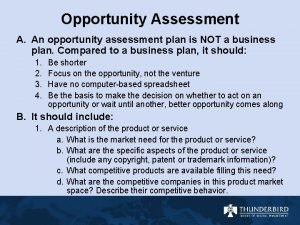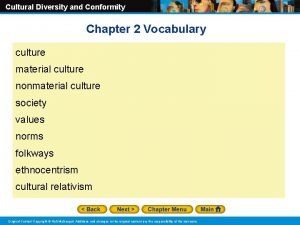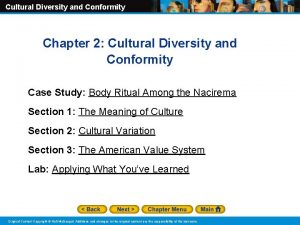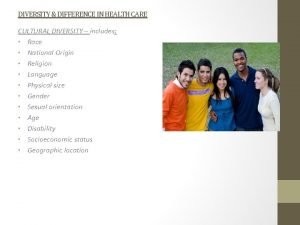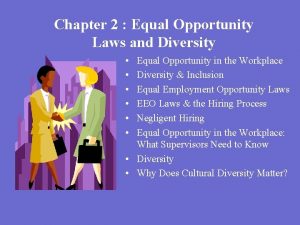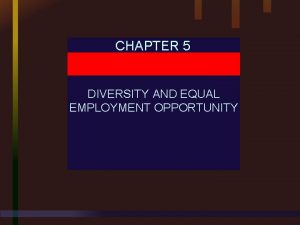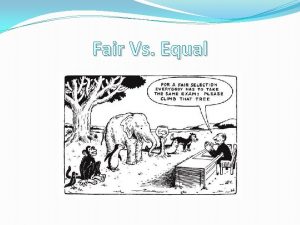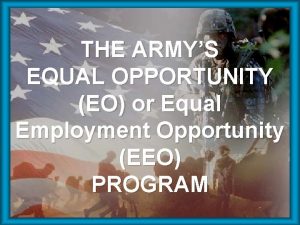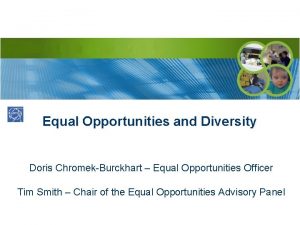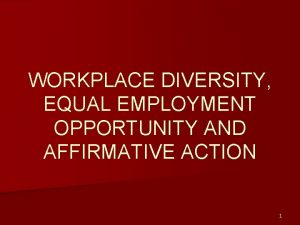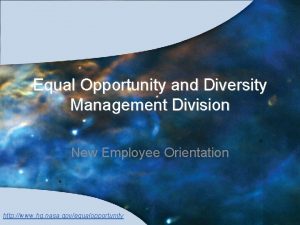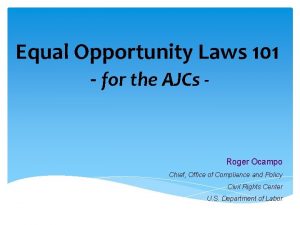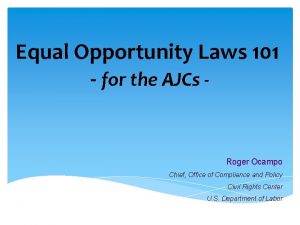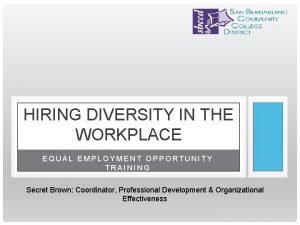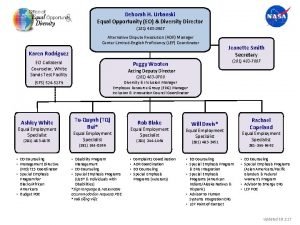Chapter 2 Equal Opportunity Laws and Diversity Equal



























- Slides: 27

Chapter 2 : Equal Opportunity Laws and Diversity • • • Equal Opportunity in the Workplace Diversity & Inclusion Equal Employment Opportunity Laws EEO Laws & the Hiring Process Negligent Hiring Equal Opportunity in the Workplace: What Supervisors Need to Know • Diversity • Why Does Cultural Diversity Matter?

Chapter 2 EQUAL OPPORTUNITY LAWS & DIVERSITY • Developing Cross-Cultural Interaction • How to Increase Personal Awareness • How to Recognize & Practice Cross. Cultural Interaction • The Value of Cultural Diversity • Managing Cultural Diversity in the Workplace • Establishing a Diversity & Inclusion Program • Managing Diversity Issues Positively

Equal Opportunity in the Workplace • The Equal Employment Opportunity Commission (EEOC): – Established in 1978 – Responsible for leading & coordinating the efforts of federal departments & agencies to enforce all laws relating to equal employment opportunity without regard to race, color, religion, sex, national origin, age, or handicap.

Culture: Our values, the way we speak, behave, think, dress, religious beliefs, the music we like, our interactions, & the food we eat. Failure to understand these diversities can result in tension, poor performance & morale, & higher rates of turnover.

The Equal Opportunity & Diversity Office provides: • Education & training the public about equal opportunity & diversity. • Advocacy for diversity. • Support for companies’ initiatives toward equal opportunity & diversity. • Consultation on best strategies for Equal Opportunity & Diversity recruitment. • Conflict mediation & resolution. • Monitoring employers’ equity & affirmative action goals. • Reviewing compliance with state & federal regulations. • Processing & resolving complaints.

Inclusion • To include everyone regardless of gender, marital status, race, national origin, religion, age, disability, sexual orientation, weight & looks.

Equal Employment Opportunity Laws • Equal Pay Act of 1963 • Civil Rights Act of 1964, Title VII • Age Discrimination in Employment Act of 1967 • The Pregnancy Discrimination Act of 1978 • The Immigration Reform & Control Act • The Americans with Disabilities Act (ADA) • The Family & Medical Leave Act of 1993

EEO Laws & the Hiring Process • Job requirements or qualifications (i. e. those regarding education & work experience) must be relevant to the job, nondiscriminatory, & predictive of job performance. • Any type of pre-employment test must be valid, reliable, & relevant to the job.

Interviewing • There are several inappropriate questions to be avoided when interviewing, such as: – How many children do you have? – What country do your parents come from? – What is your native language?

Diversity • • • Culture Ethnic Group Race Religion Language Age Gender Physical Abilities Sexual Orientation

The U. S. is becoming more diverse by the day: • By 2020 almost 1 in 3 Americans will have African, Asian, Latino, or Native American ancestry. • By 2050 almost 1 in 2! • Foodservice industries employ more Hispanics & African Americans than other industries.

Promote Inclusion • Partnering with minority -owned firms demonstrates a commitment to inclusion & creates jobs in the communities that support our businesses as patrons.

Why Does Cultural Diversity Matter? • When a group or segment is excluded or oppressed, all of us are denied. • For businesses & communities to thrive, each of us needs to be aware & sensitive to all members of the community.

Developing Cross Cultural Interaction 1. Increase personal awareness. 2. Recognize & practice cross- cultural interaction skills. 3. Maintain awareness, knowledge, & skills.

How to Increase Personal Awareness • Be careful about being culture bound: believing that your culture & value system are the best, the one & only. • Learn various facts about other cultures. • You can learn about other cultures in various ways: reading, attending cultural fairs/festivals, & interacting with individuals from other cultures.

Recognize & Practice Cross-Cultural Interaction • 3 problem areas to overcome include: – The tendency not to listen carefully or pay attention to what others are saying. – Speaking or addressing others in ways that alienate them or make them feel uncomfortable. – Using or falling back on inappropriate stereotypes to communicate with people from other cultures.

Recognize & Practice Cross-Cultural Interaction • To be an effective supervisor in a culturally diverse workforce, you must be able to: – Recognize the different ways that people communicate. – Be sensitive to your own employees’ cultural values. – Adapt accordingly.

Some Examples of Cultural Differences • • • Body Language Personal Space Eye Contact Facial Expressions Speech Being Direct in Conversation

The Value of Cultural Diversity • Supervisors & managers who are not able to handle diversity in the workforce are a liability. • Poor supervision can cost companies dearly in the following ways: – – – Discrimination lawsuits Litigation time & money Legal fees /settlements High employee turnover rates Negative community image

Leading Cultural Diversity in the Workplace • Recognize, respect, & capitalize on the different backgrounds in our society in terms of race, ethnicity, gender, & sexual orientation. • Diversity, or sensitivity, training is now commonplace in the corporate world.

Establishing a Diversity & Inclusion Program • Develop a mission statement that includes diversity & inclusion. • Develop goals for diversity & inclusion for each key operating area. • Develop objectives/strategies to show the goals will be met. • Develop measurements to monitor progress towards the goals. • Monitor progress toward goal accomplishment.

Leading Diversity Issues Positively • Get to know your employees. • Treat them equitably but not uniformly. • Watch for signs of harassment. • Foster a work climate of mutual respect. • Encourage & recognize diversity.

Gender Issues • Make sure you do not show favoritism. • Show the same amount of respect for both genders. • Know the companies sexual harassment policies, & take misconduct seriously.

Cultural Issues • Learn some of the language used by your employees (how to address them, common phrases, avoid slang). • Give meaningful & culture appropriate rewards. • If employees have trouble with English be careful when speaking to them: – Check to make sure they understand you. – Speaking a little slower might help- but do not speak too slow or too loud, this does not! • Be cautious about interpretations & the use of gestures.

Religious Issues Be consistent in allowing time off for religious reasons.

Age Issues • Treat both young & older employees with respect. • Make them equally a part of the team. • Younger workers want to have fun while doing worthwhile work, listen to them & let them participate. • Don’t have higher expectations of older adults than their peers. • Don’t patronize.

Physically &/or Mentally Challenged Issues • A differently-abled employee is a whole person with likes, dislikes, hobbies, etc. & encourage co-workers to treat them as such. • Speak directly to the differently-abled employee. • The hiring of handicapped workers has a positive effect on the economy. • Disabled workers are good for the community & for employers. • The hospitality industry has a responsibility to provide job opportunities for all. • Employees with disabilities are just as productive as other employees. • Even with great cross-cultural interaction skills, you will occasionally do something that offends an employee. – When this happens, do the commonsense thing: • Apologize sincerely! © 2010 John Wiley & Sons, Inc
 Equal opportunity and the law chapter 2
Equal opportunity and the law chapter 2 Opportunity recognition and opportunity assessment plan
Opportunity recognition and opportunity assessment plan Equal opportunity fund
Equal opportunity fund Equal opportunity illinois
Equal opportunity illinois Why is genetic diversity important
Why is genetic diversity important Genetic diversity vs species diversity
Genetic diversity vs species diversity Equal sharing is called as
Equal sharing is called as Charles de secondat
Charles de secondat Equal height equal light
Equal height equal light Taku komura
Taku komura Are opposite angles equal
Are opposite angles equal Equal area vs equal angle stereonet
Equal area vs equal angle stereonet Diversity and human needs and development
Diversity and human needs and development Chapter 8 human resources culture and diversity
Chapter 8 human resources culture and diversity Chapter 8 test human resources culture and diversity
Chapter 8 test human resources culture and diversity Chapter 5 biological diversity and conservation
Chapter 5 biological diversity and conservation Chapter 4 communication and cultural diversity
Chapter 4 communication and cultural diversity Sociology chapter 2 cultural diversity and conformity
Sociology chapter 2 cultural diversity and conformity Cultural diversity and conformity chapter test form a
Cultural diversity and conformity chapter test form a Sociology chapter 2: cultural diversity and conformity
Sociology chapter 2: cultural diversity and conformity Growth diversity and conflict chapter 4
Growth diversity and conflict chapter 4 Chapter 4 growth diversity and conflict
Chapter 4 growth diversity and conflict Chapter 13 cultural diversity and community health nursing
Chapter 13 cultural diversity and community health nursing Government chapter 21 diversity and discrimination
Government chapter 21 diversity and discrimination Cultural diversity 3939 answers
Cultural diversity 3939 answers Chapter 24 animal evolution diversity and behavior
Chapter 24 animal evolution diversity and behavior Chapter 13 diversity and difference in health care
Chapter 13 diversity and difference in health care Chapter 5 biological diversity and conservation
Chapter 5 biological diversity and conservation

